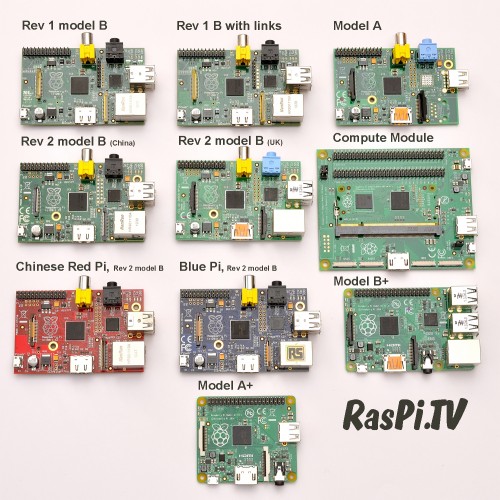| Liz: Today’s guest post comes from Alex Eames, who runs the rather wonderful RasPi.TV. He’s been furtling through his drawers, and has discovered he owns a surprising number of Raspberry Pi variants. Thanks Alex! Now we have the A+, I thought it'd be a good time to celebrate its 'birth' by having a rundown of the various mass-produced models of Raspberry Pi. I had a look through my collection and was somewhat surprised to see that I have 10 different variants of Raspberry Pi now. There is one I don't have, but more about that later. Here's the family photo. You can click it for a higher resolution version. Rev 1 Model BIn row 1, column 1 we have the Rev 1 model B. Although I was up early on 29th February 2012, I didn't get one of the first 10,000 Pis produced. This was delivered in May 2012. It's a Farnell variant (I have an RS one as well, but it does full-time duty as my weather station). This was the original type of Pi to hit the market. It has 256 Mb RAM and polyfuses on the USB. Rev 1 Model B – With LinksIn row 1, column 2 you'll see a slightly later variant of Rev 1 model B. This one has 0 Ohm links instead of polyfuses. It helped to overcome some of the voltage drop issues associated with the original Rev 1, but it introduced the "hot-swapping USB devices will now reboot your Pi" issue, which was fixed in the B+. Rev 2 Model B (China)Row 2, column 1. Here we have an early Rev 2 Pi. This one was manufactured in China. It originally had a sticker on saying "made in China", but I took it off. This one was bought some time around October 2012. The Rev 2 model B has 512 Mb RAM (apart from a few early ones which had 256 Mb), mounting holes and two headers called P5 and P6. Rev 2 Model B (UK)Row 2, column 2. This is a much later Rev 2 Pi, made at SONY in Wales, UK. Chinese Red Pi Rev 2 Model BRow 3, column 1. This is one of the Red Pis made especially for the Chinese market. They are not allowed to be sold in the UK, but if you import one yourself that's not a problem. It is manufactured to a less stringent spec than the ones at SONY, and is not EMC tested. Therefore it bears no CE/FCC marks. Limited Edition Blue Pi Rev 2 Model BRow 3, column 2. I'm not going to go into how I got hold of this. Suffice it to say it was not at all easy, but no laws were broken, and nobody got hurt. RS had 1000 of these made in March 2013 as a special limited anniversary edition to use as prizes and awards to people who've made a special contribution to education etc. I know of about 5 or 6 people who have them. (At least two of those people traded for them.) They are extremely hard to get. They come in a presentation box with a certificate. I have #0041. Other than their blueness, they are a Rev 2 model B Pi. Model ARow 1, Column 3 is a model A. The PCB is identical to the Rev 2 model B, but it has only one USB port, no ethernet port, no USB/ethernet chip and 256 Mb RAM. The $25 model A was released in February 2013. On the day I got mine, the day after launch, I made a quick and dirty "I've got mine first" video, part of which ended up on BBC Click. The model A sold about 100k units. Demand for it was outstripped by the model B, although at one point CPC was offering a brilliant deal on a camera module and model A for £25 (I snagged a couple of those). Compute ModuleRow 2, column 3 is the Compute Module, sitting atop the Compute Module development board. This was launched 23 June 2014 as a way to enable industrial use of the Pi in a more convenient form factor. The module is made so it fits in a SODIMM connector and is essentially the BCM 2835, its 512 Mb RAM and 4 Gb of eMMC flash memory with all available GPIO ports broken out. It costs $30 when bought by the hundred. Model B+Row 3, column 3 is the model B+. This was launched on 14 July 2014 and was a major change in form factor. Rounded corners, corner mount holes, 40 GPIO pins, 4 USB ports, improved power circuitry and a complete layout redesign. The B+ was announced as the 'final revision' of the B. So it would appear that it's going to be with us for some time. Model A+In row 4, all by itself we have the shiny new Raspberry Pi A+, launched 10 November 2014. It's essentially the same as a B+ with the USB end cut off. It's the smallest, lightest, cheapest, and least power-hungry Pi of all so far. It's 23g, $20 and uses just half a Watt at idle. So Which One Don't I Have?I don't have a Rev 2 256 MB variant. If you have one and would like to trade or sell it to me, I'd be happy to hear from you (alex AT raspi.tv). I believe there is also now a red Chinese B+ I've not got one of those, but it's only a matter of time. I wonder if there will be a red A+ at some point too? We Just Don't Know!
|
A Semi-automated Technology Roundup Provided by Linebaugh Public Library IT Staff | techblog.linebaugh.org
Wednesday, November 19, 2014
A collection of Pis
Subscribe to:
Post Comments (Atom)

No comments:
Post a Comment